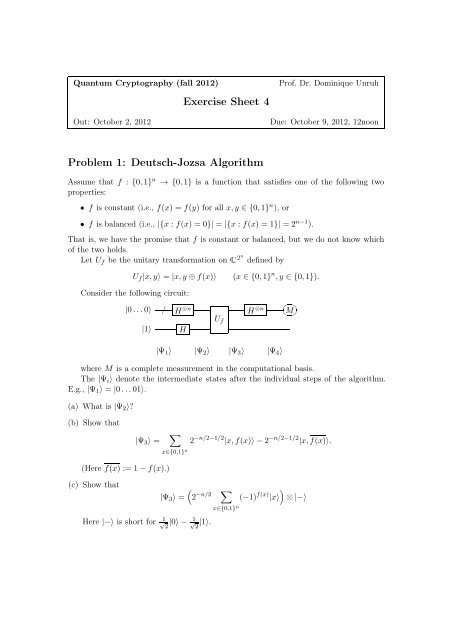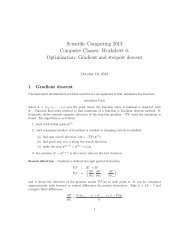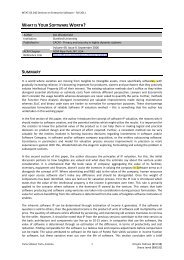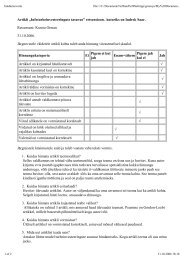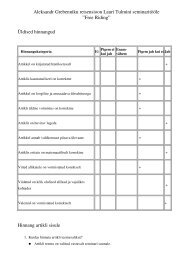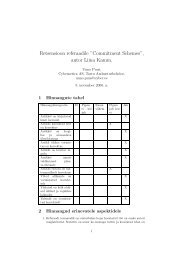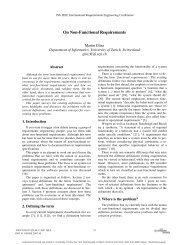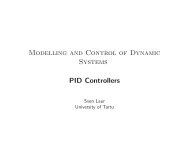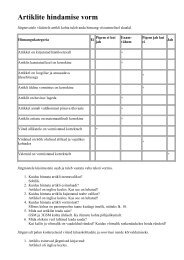Homework 4
Homework 4
Homework 4
You also want an ePaper? Increase the reach of your titles
YUMPU automatically turns print PDFs into web optimized ePapers that Google loves.
Quantum Cryptography (fall 2012) Prof. Dr. Dominique Unruh<br />
Exercise Sheet 4<br />
Out: October 2, 2012 Due: October 9, 2012, 12noon<br />
Problem 1: Deutsch-Jozsa Algorithm<br />
Assume that f : {0,1} n → {0,1} is a function that satisfies one of the following two<br />
properties:<br />
• f is constant (i.e., f(x) = f(y) for all x,y ∈ {0,1} n ), or<br />
• f is balanced (i.e., |{x : f(x) = 0}| = |{x : f(x) = 1}| = 2 n−1 ).<br />
That is, we have the promise that f is constant or balanced, but we do not know which<br />
of the two holds.<br />
Let Uf be the unitary transformation on 2n defined by<br />
Uf|x,y〉 = |x,y ⊕f(x)〉 (x ∈ {0,1} n ,y ∈ {0,1}).<br />
Consider the following circuit:<br />
|0...0〉 / H ⊗n<br />
|1〉 H<br />
Uf<br />
H ⊗n<br />
|Ψ1〉 |Ψ2〉 |Ψ3〉 |Ψ4〉<br />
<br />
<br />
M<br />
where M is a complete measurement in the computational basis.<br />
The |Ψi〉 denote the intermediate states after the individual steps of the algorithm.<br />
E.g., |Ψ1〉 = |0...01〉.<br />
(a) What is |Ψ2〉?<br />
(b) Show that<br />
|Ψ3〉 = <br />
(Here f(x) := 1−f(x).)<br />
(c) Show that<br />
x∈{0,1} n<br />
|Ψ3〉 =<br />
2 −n/2−1/2 |x,f(x)〉−2 −n/2−1/2 |x,f(x)〉.<br />
<br />
−n/2<br />
2<br />
Here |−〉 is short for 1<br />
√ 2 |0〉− 1 √ 2 |1〉.<br />
x∈{0,1} n<br />
(−1) f(x) <br />
|x〉 ⊗|−〉
(d) Show that H ⊗n |x〉 = 2 −n/2<br />
z∈{0,1} n(−1)x·z |z〉 where x·z := n<br />
i=1 xizi.<br />
(e) What is |Ψ4〉?<br />
(f) Show that the probability P of measuring 0...0 in the measurement is<br />
2 −n <br />
x∈{0,1} n(−1)f(x) 2 .<br />
(g) Compute the probability P of measuring 0...0 in the case that f is constant.<br />
(h) Compute the probability P of measuring 0...0 in the case that f is balanced.<br />
Problem 2: Ensembles and Density Operators<br />
(a) Consider the following quantum ensembles:<br />
E1 = {(|0〉, 1 1<br />
2 ),(|+〉, 2 )},<br />
E2 = {(|0〉, 1<br />
4<br />
E3 = {(|0〉, 1<br />
4<br />
),(|1〉, 3<br />
4 )},<br />
),(|1〉, 1<br />
4<br />
),(|+〉, 1<br />
4<br />
),(|−〉, 1<br />
4 )}.<br />
Compute the corresponding density operators ρ1,ρ2,ρ3. (Note: |+〉 := 1<br />
√ 2 |0〉+ 1<br />
√ 2 |1〉<br />
and |−〉 := 1 √ 2 |0〉− 1 √ 2 |1〉.)<br />
(b) Consider the following process: First, a random value x ∈ {0,1} n is chosen. Then<br />
an n-bit quantum register is prepared to have the value |Ψ〉 := |x〉. Then a unitary<br />
transformation U is applied to Ψ. What is the density operator corresponding to the<br />
resulting ensemble?<br />
Hint: As the first step, consider the case that U is the identity.<br />
(c) Let a measurement M consisting of projectors P1,...,Pn be given. Let a quantum<br />
state |Ψ〉 be given. Assume that |Ψ〉 is measured using M but the measurement<br />
outcome is not recorded (i.e., it is forgotten, erased). What is the ensemble describing<br />
the state of the system after this experiment? What is the corresponding density<br />
operator?<br />
(d) Assume a quantum system is in the state described by a density operator ρ. We apply<br />
a measurement M consisting of projectors P1,...,Pn to the system and forget the<br />
outcome. What is the density operator describing the resulting state of the system?
(e) Consider the following experiments:<br />
• Experiment A: A two-qubit system is initialised with probability 1<br />
state 1<br />
√ 2 |00〉+ 1 √ 2 |11〉 and with probability 1<br />
2<br />
to be in the state 1<br />
to be in the<br />
2<br />
√ |00〉−<br />
2 1 √ |11〉.<br />
2<br />
• Experiment B: A random bit r is chosen, and then both qubits are individually<br />
prepared to be in the same state |r〉.<br />
Note that in experiment A, we have entanglement: The state 1 √ 2 |00〉+ 1<br />
√ 2 |11〉 cannot<br />
be written in the form |Ψ1〉⊗|Ψ2〉 (same for 1 √2 |00〉− 1 √ 2 |11〉). On the other hand,<br />
in experiment B, in each of the two cases r = 0 and r = 1, a state is prepared that<br />
is separable (of the form |Ψ1〉⊗|Ψ2〉).<br />
Show that the states produced in the two experiments are physically indistinguishable.<br />
(f) In the lecture, we mentioned several times that a global phase, i.e., a factor ϕ ∈ <br />
with |ϕ| = 1 in front of a quantum state, is physically irrelevant.<br />
Demonstrate this by showing that the two states |Ψ〉 and ϕ|Ψ〉 are physically indistinguishable.<br />
1<br />
1 More precisely, the ensembles {(|Ψ〉,1)} and {(ϕ|Ψ〉,1)}.


